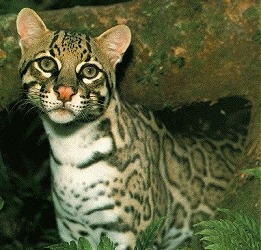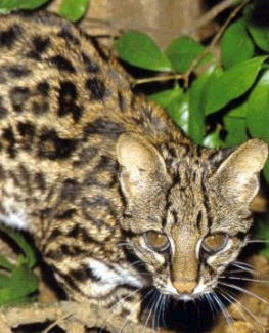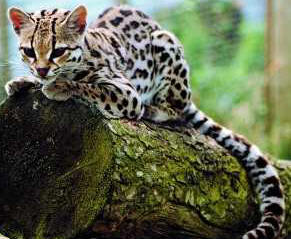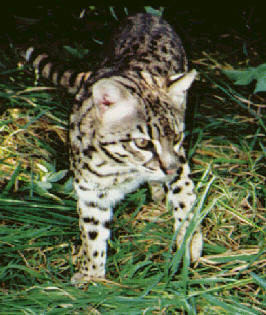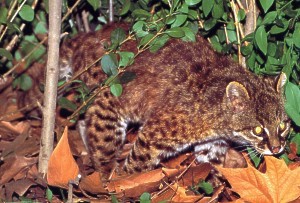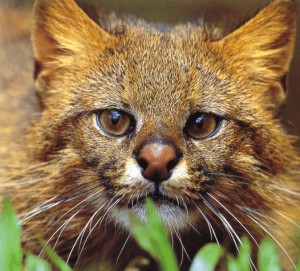|
Genus Leopardus The Ocelot (Leopardus pardalis) is perhaps the most well known of the small cats and this mostly is the doing of the pelt and exotic pet trade. The ocelot is a terrestrial nocturnal hunter but an arboreal sleeper. Their prey consists of birds, rodents, snakes and lizards. The range of this cat is from southern Texas to Argentina but it used to be more extensive and more densely populated. The Texas population only harbors a mere 100 individuals and is still on the decline due to road kill incidents. The fur trade is also a demanding pressure on this cats livelihood as every coat takes one dozen adult cat skins. And some females may have cub bringing the number of casualties up. |
|
| The Oncilla (Leopardus tigrina) is found from Costa Rica to Argentina. This little 5 pound cat has many titles like Tigrina or Tiger cat. They live in lowland rainforests, cloud forests, and some higher elevations of 3,000 feet and are well adapted to climbing the foliage of their environment. Little is known of this cats behavior except that it is a solitary cat and is likely to feed on small mammal, reptiles, and birds. The Oncilla sports a beautiful rosette patterned coat which has been much the envy of the fur trade along with the Margay and the Ocelot. This along with deforestation threatens to be this tiny cat's undoing. |
|
| The Margay (Leopardus wiedii) is almost just a small Ocelot in appearance. It is found from Mexico to Argentina in the dense tropical rainforests of these areas. With it long tail and other arboreal adapted qualities ,such as flexible ankles, this cat is a superb tree climber and hunter. Being a nocturnal feline, it scans the night's elevated locations for birds, reptiles, rodents, and insects. Its lengthy whiskers help it to navigate the darkness with accuracy and its large eyes are acute at night vision. Margays communicate with varying vocalizations from purring to meowing and hissing. Also gesturing is a common communication skill of this agile cat. |
|
|
Genus Oncifelis The Geoffroy's Cat (Oncifelis geoffroyi) is found in parts of Brazil, Paraguay, Uruguay, Chile, Bolivia, and Argentina. This cat is a ground hunter as well a tree hunter but is hard to track because it only excretes waste in the trees. This cat lives in open bush, rocky terrain, scrub woodlands and forests in the vicinity of rivers. It eats rodents, reptiles, birds, and insects and has been said to drop on them from the trees. This cat is a day sleeper and finds the trees good refuge for this vulnerable yet necessary action. Poachers have reduced the Jaguar population as well as other spotted cats of South America and now are turning to the Geoffroy's Cat as a new resource. |
|
| The Kodkod (Oncifelis guigna) may be the smallest cat in the Americas only rivaled by the Oncilla for this position. Small areas of Chile and Argentina are its only refuges. It lives in coniferous forests, woodland areas and semi-open areas. Hardly anything is known of this cats habits as it is rare and elusive. The Kodkod is especially vulnerable to habitat destruction because it lives in restricted areas. Kodkods look a lot like the Geoffroy's Cat yet one big difference is the Kodkod's stocky tail. |
|
| The Pampas Cat (Oncifelis colocolo) comes in many different colors from a dark black to the reddish-orange seen at the right. They are about the size of a domestic cat and can be confused if not for the pointed ears and in the case of the Brazilian ones, a large nose. They also have a mane of hair they raise on their backs to show aggression.They are found in many areas of South America and are live in a variety of habitats. Little is known of this cat behavior but it is thought that they are terrestrial hunters stalking rodents and ground nesting birds. |
|
|
Genus Oreailurus The Andean Mountain Cat (Oreailurus jacobita) is a rare cat found in the high Andes. It was discovered in 1865 but it took till 1980 to have a sure sighting and it is only known from a few photos and pelts. Like the snow leopard this cat is at home it high altitudes. This 5 pound cat's gray spotted coat provides warm and camouflage in the rocky bare terrain that is found in the high Andes. The cat's ability to hide, the desolate climate and the its rarity make Andean Mountain Cats hard to find. |
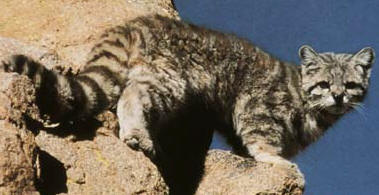 |
